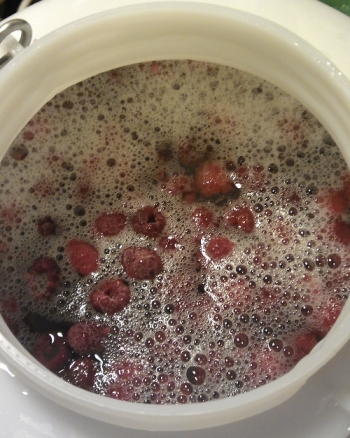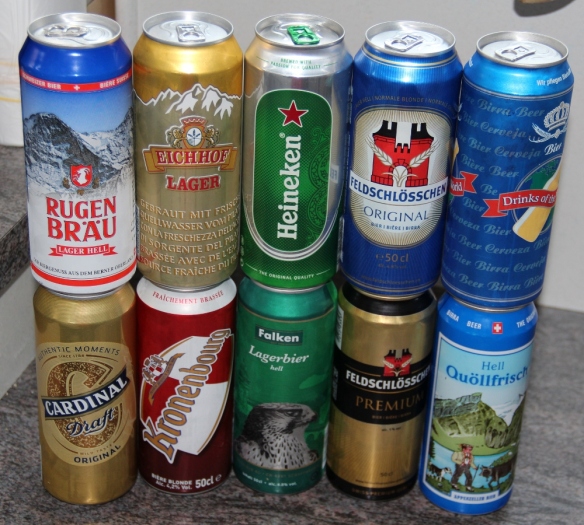Eureka, its time for a relatively recent batch. The recipe below is for a pretty standard Saison beer dry hopped with some Saazer hops. My goal was to brew a dry, low alcohol Saison with a lot of hop character. In my opinion, the most important parts for a Saison beer is the right yeast and the right fermentation temperature to get a high attenuation level and the dryness in the beer. I chose Wyeast’s private collection strain #3726 Farmhouse Ale but any other year around Saison strain should work as well. To get the Saison yeast running, warm fermentation temperatures of approximately 28°C (82°F) are necessary. I brewed the beer last Summer and left a big vat filled with water in my shed and submerged the fermentation vessel in the vat. During the day the water temperature increased to approximately 30 – 35°C (86 – 95°F) and the temperature stayed warm during the night as well. I guess this is not a very sophisticated method to keep your fermentation vessel warm since the temperature is not stable and might influence the yeast. Lets go through the recipe first. Oh, I forgot to mention that I bottled half of the Saison with some raspberries…
| Recipe: | Manneken Pis Saison | |
| Numbers: | Volume [L] | 19 (5 gal) |
| Original gravity | 9°P (1.035) | |
| Terminal gravity | 1.7 – 2.3°P (1.006 – 1.008) | |
| Color | Around 6 EBC | |
| IBU | 28 IBU | |
| ABV | 3.5 – 3.9% (v/v) | |
| Grains: | Pilsner malt (4 EBC) | 3.4 kg |
| Wheat malt (4 EBC) | 0.23 kg | |
| Hops: | Saazer (3.2% AA) | 52.5 g and boil for 60 min |
| Hallertauer (4.2% AA) | 26.7 g and boil for 10 min | |
| Hallertauer (4.2% AA) | 26.7 g and boil for 0 min | |
| Saazer (3.2% AA) | 52.5 g and boil for 0 min | |
| Saazer (3.2% AA) | 32 g for dry hopping | |
| Yeast: | Wyeast’s | #3726 Farmhouse Ale |
| Water: | Burgdorf | Mash: 9 L (2.4 gal), sparge: 15 L (4 gal) @78°C (172°F) |
| Rest: | Mash in @64°C (147°F), 90 min @64°C (147°F), 10 min @ 78°C (172°F) | |
| Boil: | Total 90 min | |
| Fermentation: | Primary | 12 days @28°C (82°F) in plastic fermenter |
| Secondary | 1 month @20°C (68°F) in plastic fermenter | |
| Maturation: | Carbonation (CO2 vol) | 3 with sugar addition |
| Maturation time | > 21 days | |
08/11/2012: Brew day number 63. Crushed the grains, mashed in at 64°C and left the mash convert for 90 min. Then sparged and boiled the wort for 90 min with the hop additions mentioned in the protocol above. Then cooled down the wort and pitched fresh Farmhouse Ale yeast and submerged the fermentation vessel in the vat in my shed.
08/23/2012: Racked to secondary fermenter after 12 days of primary fermentation. Gravity down to 2.1°P already. Did the secondary at 20°C (68°F).
08/24/2012: Removed 10 L of the secondary fermenter, transferred into a smaller fermenter and added 2 kg of frozen raspberries:
 09/15/2012: Bottled the raspberry version to a carbon dioxide level of 3 vol and added the Saaz hops to the version without the raspberries.
09/15/2012: Bottled the raspberry version to a carbon dioxide level of 3 vol and added the Saaz hops to the version without the raspberries.
09/22/2012: Bottled the Saison without the raspberries to a carbon dioxide level of 3 vol. I then left the bottles carbonate for approximately three weeks at ambient temperatures and store the bottles at lower temperatures (not in a refrigerator) since.
Manneken Pis Saison sensory evaluation (after 7 months in bottle):
 Aroma: Lots of phenolic and pepper. Smells really nice. Hint of Saazer hops in the nose as well.
Aroma: Lots of phenolic and pepper. Smells really nice. Hint of Saazer hops in the nose as well.
Appearance: Yellow, frothy white, long- lasting head, clear (with some grain chunks)
Flavor: Phenolic and spicy driven beer with some lavender and ginger. Really nice!
Mouthfeel: Light body, average carbonation, dry finish
Overall Impression: Really refreshing with its ABV of 4.5%. Nice phenolic, spicy character.
Manneken Pis Saison sensory evaluation (after 7 months in bottle) with B. lambicus addition at bottling:
Aroma: Phenolic, pepper in the front and leathery in the back. Definitely picking up some Brett funk in the nose. Even some urine smell…
Appearance: Yellow, frothy white, long-lasting head, clear (with some grain chunks). Looks the same as the non-Brett Saison.
Flavor: Again phenolic and spicy notes dominate on the palate. No Brett funk detectable.
Mouthfeel: Light body, average carbonation level, grassy finish with light funky tang (tart and astringent).
Overall Impression: Flavor profile is close to no Brett Saison. The Brett only contributes to additional components in the smell and the tart, astringent finish. To be honest, I prefer the Brett infused Saison over the clean one. It kind of makes this beer a bit bolder and down-to-earth and reminds me of the original Saison setting (barnyard, refreshing beer). Really looking forward what will happen to this beer in the future.
Raspberry infused Manneken Pis Saison sensory evaluation (after 8 months in bottle):
 Aroma: Dry raspberry smell with some grassy-herbal background notes. No hops or any phenolic, pepper aroma
Aroma: Dry raspberry smell with some grassy-herbal background notes. No hops or any phenolic, pepper aroma
Appearance: Red, clear with some fruit debris, nice pink head
Flavor: Very light raspberry flavor. Very dry
Mouthfeel: Light body, average carbonation level, dry fruity, grassy finish
Overall Impression: Fresher examples had more raspberry on the palate. Nevertheless, this is a very nice beer. Really enjoying this. And not sweet like many other fruit beers. Really interesting!
Really happy how all these beers turned out differently. I will do another batch of this recipe soon (without the raspberries) and play around with some different Brettanomyces strains. The raspberries were just a small experiment to see how much raspberries are necessary to get some of the fruit flavor into the beer. I will focus on some Berliner Weisse recipes soon and one share will be made with some raspberries. 200 g fruits per Liter of beer seem to work very well. Cheers!


 We selected the following beers: Feldschlösschen Original (Feldschlösschen being the biggest brewery in Switzerland and part of Carsberg) and maybe one of the most sold beers in Switzerland, Feldschlösschen Premium, Rugenbräu Lager Hell (independent brewery), Cardinal Draft (brewery owned and closed by Feldschlösschen), Eichhof Lager (brewery owned by Heineken), Kronenbourg (French brewery owned by Carlsberg), Heineken, Falken Lagerbier hell (independent brewery), Quöllfrisch Hell (independent brewery) and finally a beer brewed for a liquor store chain in Switzerland called “Drinks of the world”. The beer landscape in Switzerland is very typical: Some big ones and a lot of small, independent ones. The big ones in Switzerland are Carlsberg and Heineken.
We selected the following beers: Feldschlösschen Original (Feldschlösschen being the biggest brewery in Switzerland and part of Carsberg) and maybe one of the most sold beers in Switzerland, Feldschlösschen Premium, Rugenbräu Lager Hell (independent brewery), Cardinal Draft (brewery owned and closed by Feldschlösschen), Eichhof Lager (brewery owned by Heineken), Kronenbourg (French brewery owned by Carlsberg), Heineken, Falken Lagerbier hell (independent brewery), Quöllfrisch Hell (independent brewery) and finally a beer brewed for a liquor store chain in Switzerland called “Drinks of the world”. The beer landscape in Switzerland is very typical: Some big ones and a lot of small, independent ones. The big ones in Switzerland are Carlsberg and Heineken.





